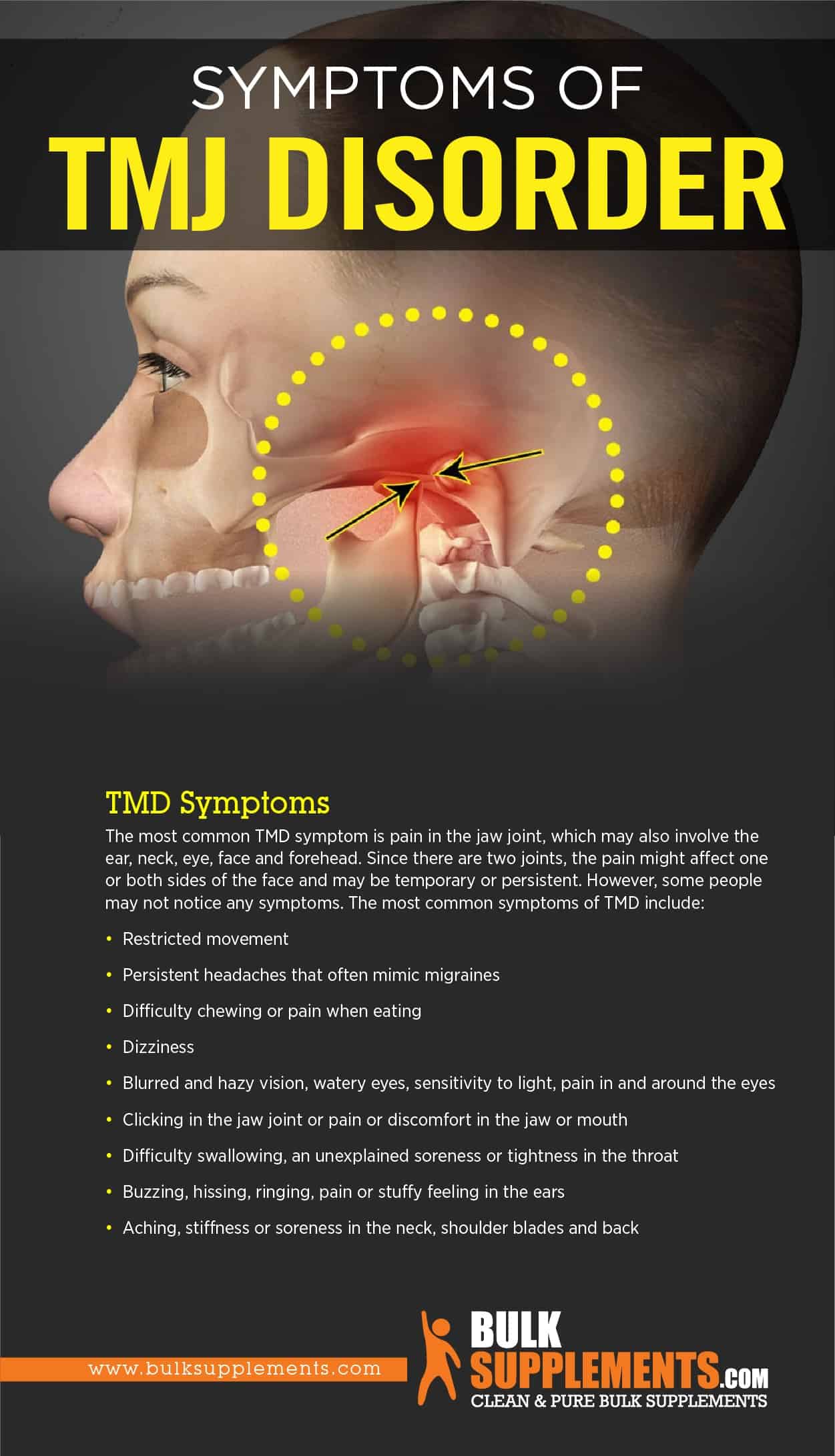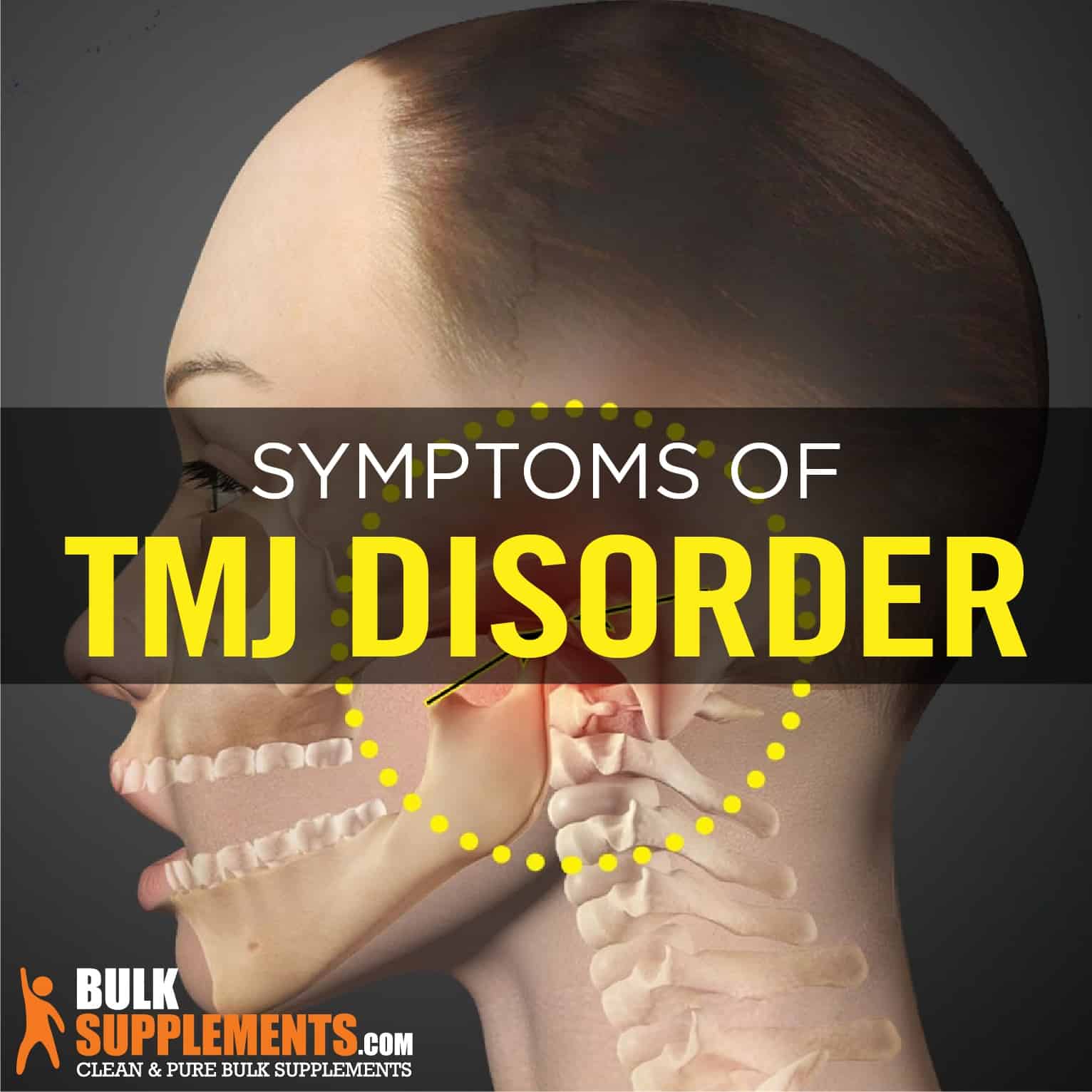What is TMJ?
The temporomandibular joint (TMJ) is a hinge that joins the jaw to the temporal bones of the skull, usually found in front of each ear. TMJ springs into action each time you chew, yawn, talk or swallow.
What is TMD?
TMD is a group of disorders that occur in the TMJ, causing pain in this area (x). It is reported that about 12 percent of people in the United States experience TMJ disorders (x).
Causes of TMJ Disorder
The exact cause of TMD may be difficult to pinpoint. Some symptoms are caused by medical conditions and require diagnosis and treatment by a professional, but sufferers of TMD may also be able to reverse their symptoms by changing a behavioral pattern. Causes of TMD include (x, x):
Bruxism
Bruxism is characterized by repetitive grinding or clenching of the teeth, which adds pressure to the joint between the ball and socket of the jaw and wears down the cartilage. There are two types of bruxism — awake and asleep — that stem from frustration, tension and anger and often happen involuntarily (x, x).
Hormonal Imbalance
Research shows that women are more prone to TMJ pain than men. Some studies indicate that there could be a link between estrogen imbalances and jaw disorders (x). Estrogen can also lead to a cartilaginous breakdown in the jaw joint, resulting in TMJ disorders (x, x).
Stress
TMJ frequently worsens with stress. Stress and tension causes jaw clenching and teeth grinding, which aggravates TMD symptoms. Stress also increases cortisol secretion, an acid that contributes to hormonal imbalances and triggers inflammation (x).
Osteoarthritis
Osteoarthritis is caused by cartilage breakdown, changes in the joints, deterioration of tendons, and inflammation. It’s triggered by immunologic and inflammatory diseases. Just like any other joint in the body, the jaw joint is also at risk for arthritic changes that result from degeneration or breakdown of the joint or from wear and tear with age (x, x).
Rheumatoid Arthritis
Rheumatoid arthritis is an autoimmune disease that causes persistent inflammation in the joints, which may affect the TMJ. When rheumatoid arthritis progresses, it can lead to cartilage destruction, bone erosion and eventually bone deformity (x, x, x).
Facial Trauma
Facial trauma, such as fracture of the mandibular condyle, misaligned teeth or whiplash injury to the jaw joint, can damage the TMJ. Conditions like fusion and fibrous adhesion can also disrupt the balance of the TMJ (x).
Malocclusion
People may have misaligned teeth due to conditions like an anterior open bite — a protrusion of the upper front teeth — missing teeth, cross-bite and faulty dental fillings. This may also cause TMJ disorder (x).
Chewing Gum
Studies show that frequent and intensive gum chewing may increase the prevalence of TMJ pain and TMJ disorder (x).
TMD Symptoms
The most common TMD symptom is pain in the jaw joint, which may also involve the ear, neck, eye, face and forehead. Since there are two joints, the pain might affect one or both sides of the face and may be temporary or persistent. However, some people may not notice any symptoms. The most common symptoms of TMD include (x, x):
- Restricted movement
- Persistent headaches that often mimic migraines
- Difficulty chewing or pain when eating
- Dizziness
- Blurred and hazy vision, watery eyes, sensitivity to light, pain in and around the eyes
- Clicking in the jaw joint or pain or discomfort in the jaw or mouth
- Difficulty swallowing, an unexplained soreness or tightness in the throat
- Buzzing, hissing, ringing, pain or stuffy feeling in the ears
- Aching, stiffness or soreness in the neck, shoulder blades and back

Risk Factors for TMJ Disorder
Certain conditions may increase the likelihood of developing TMD. Some of the risk factors are:
Chronic Pain Conditions
TMJ disorder may be associated with chronic pain disorders, such as functional dyspepsia, tension headache, irritable bowel syndrome and painful bladder syndrome. Researchers have not yet discovered the specific relationship between these conditions, known as functional pain syndromes. However, studies show that these disorders often coexist in the same individuals (x).
Psychological Factors
Psychological conditions, such as depression and anxiety, are commonly associated with chronic pain disorders, including TMJ disorder (x).
Sleep Apnea
TMD is closely related to obstructive sleep apnea, a condition characterized by intermittent airflow blockage during sleep. Studies show that TMJ disorder is three times as likely to occur in people prone to sleep apnea (x).
Prolonged Dental Treatments
Those diagnosed with TMJ disorder may commonly experience pain after dental work, such as extractions or orthodontic procedures. Patients often experience TMJ pain after holding the jaw in an uncomfortable position during long dental procedures (x).
Gender
TMJ pain is more common in women than in men, with nine women to every one man experiencing restricted jaw movement and severe pain (x). This correlation has prompted researchers to look into hormonal causes of TMJ disorder.
Diagnosing TMJ Disorder
There is no specific test for TMD. During diagnosis, the doctor discusses the patient’s medical history, symptoms and performs a physical exam by (x):
- Listening to and feeling the patients jaw when they open and close their mouth
- Observing the range of motion in the patient’s jaw
- Pressing around the patient’s jaw to identify sites of pain and discomfort
If the physician suspects a problem, he or she may:
- Send the patient to an oral and maxillofacial specialist, an otolaryngologist or a dentist who specializes in jaw disorders
- Order dental X-rays to evaluate the patient’s teeth and jaw
- Order an MRI to examine the TMJ joint
TMJ Arthroscopy
Physicians can also use TMJ arthroscopy, an imaging technique to diagnose TMJ. In this procedure, a doctor inserts a small camera called an arthroscope into your joint space to help view and diagnose the problem (x).
TMJ Disorder Treatment Options
TMD treatment aims to address the underlying cause of TMJ pain and to ease discomfort.
Medication
Some medication options can be coupled with other nonsurgical treatments (x):
- Nonsteroidal anti inflammatory drugs, such as aspirin or ibuprofen
- Muscle relaxants, used to relieve TMJ pain and relax jaw muscles
- Antidepressants, used in low doses to control pain
- Antianxiety medication, to relieve stress associated with TMJ disorder
Therapy
In addition to medication, there are non-drug therapies including (x):
- Physical therapy, used with exercise to help stretch and strengthen jaw muscles
- Mouth guards to stabilize the jaw joint in a healthy position
Surgical Procedures
If other treatment procedures don’t reduce the symptoms, doctors may use surgical procedures as a last resort:
Injection
Corticosteroid injections help reduce inflammation and pain in the TMJ joint using ultrasound technology (x).
Arthroplasty
Physicians use arthroplasty, or “open joint” surgery in cases where jaw pain appears to be caused by a structural problem. It allows for realignment of the disc that opens and closes the jaw. This surgery requires a larger incision and a longer recovery time (x).
Arthrocentesis
In this procedure, a doctor inserts a small needle into the joint and adds fluid to remove debris or inflammation (x).
Supplements & Herbal Remedies for TMJ Disorder
Kava Kava Extract Powder
As a dietary supplement, take 1000 mg (scant 1/2) tsp) of kava kava extract powder once or twice daily or as directed by a physician.
Magnesium
As a dietary supplement, take 2,600 mg (scant ¾ tsp) of magnesium aspartate powder once or twice daily, or as otherwise directed by a physician (x).
Valerian
Take 300 to 600 mg of valerian root extract powder daily depending on the intended effect, or as directed by a physician. For best results, it should be taken two hours before sleep.
Collagen
Collagen is a protein that helps rebuild tissue, including cartilage. Take 2,500 mg (scant ½ tablespoon) of collagen powder two to four times daily, or as directed by a physician (x).
Glucosamine
As a dietary supplement, take 100 mg (rounded ¼ tsp) of glucosamine powder up to three times daily (x).
Chondroitin Sulfate
As a dietary supplement, take 750 mg to 1,500 mg of chondroitin powder daily, or as directed by a physician.
The Bottom Line
If you experience jaw pain when you open your mouth, you could be suffering from TMJ disorder. The most common symptoms include pain, difficulties chewing, difficulties sleeping, headaches, dizziness, joint pain, ringing in the ears and swelling around the jaw and face. However, some people might not notice any symptoms at all. Treatment for TMJ disorder may involve targeted exercise, sleep, reducing stress and natural remedies or supplements.


